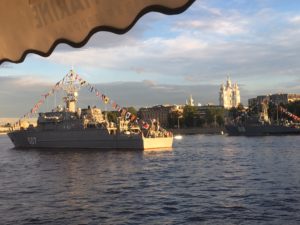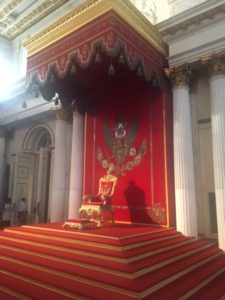Over the course of my time here in Saint Petersburg, I have had the opportunity to meet a variety of locals and tourists, see several holidays, and take part in the culture of the city. I have attended 5 major music concerts. First, I saw the last concert of the season by the St. Petersburg Philharmonic Orchestra, playing works by famous Russian composers. I watched an open-air, free-to-the-public performance of the early Russian opera Ruslan and Lyudmila. Then, over the span of just six days, I saw Tchaikovsky’s famous ballet Swan Lake, Gounod’s French grand opera Faust, and lastly, Eugene Onegin, the most famous Russian opera. These were interesting experience not only musically but also linguistically. Opera is not easy to understand even in your native language, and trying to follow in Russian was a steep challenge.
The past week saw two holidays: Navy Day and Paratroopers’ Day. While I tried as best I could to experience them, this was not very easy. Navy Day, or День Военно-морского Флота (Den’ Voenno-morskovo flota), is a major holiday; Putin was present, along with dozens of navy ships. Unfortunately, this also brought remarkable crowds filling the streets and bridges. I gave up on trying to get to the Neva River to see the ships after about an hour. I was able to watch the fireworks display that night from my room. Luckily, I had previously seen several of the ships on the water on prior days.

I did have the chance to learn more about the holiday and its significance. I talked to Sergey, the primary tour guide for my program’s excursions, about Navy Day. He told me about the history of the holiday, specifically its Soviet origins and now how it has spread to numerous other countries. It still marks one of the biggest days of Russian national pride: after all, Russia Day, their independence day, is not strongly celebrated—it marks freedom from itself, something many struggle to find pride in. Especially in the context of increasingly strained relations with the U.S., Navy Day is also a chance for Russia to flex its military might, another tradition dating to 1939, the first Navy Day in what was then the Soviet Union. Its primary and most official purpose, however, is for honoring the Russian Navy, just as with Memorial Day or Veteran’s Day in America. I also talked, while trying to weave through the crowds, to a Russian I met about the holiday. He viewed it less as a solemn celebration of the past and more of a chance for nationalistic braggadocio. For most Russians, he told me, it is primarily a chance to drink lots of vodka, see some cool military ships, watch fireworks, and feel patriotic pride. I related it to the way that many Americans celebrate the 4th of July.
Additionally, Paratroopers’ Day, in Russian День Воздушно-десантных Войсков (Den’ Vozdushno-desantnykh Voyskov, generally shortened to День ВДВ, Den’ VDV), occurred on Wednesday. While technically a celebration of the Russian Air Force—it is literally the Day of Air-landing Forces—in practice, most do not celebrate the holiday. Those who do are generally young men who wear light blue striped tank tops, drink large volumes of vodka, and swim in some of the many fountains around the city.
I, per the advice of those familiar with the holiday, avoided the celebrators, called paratroopers; I instead finally visited the Hermitage, the largest art museum in the world. There was far too much to possibly pick a favorite work of art, so I will cop out by showing not a painting or sculpture, but rather a throne: the Hermitage is housed in what was once the Winter Palace, and this is the throne room of the Russian emperors of old.
